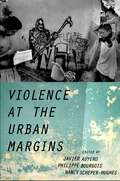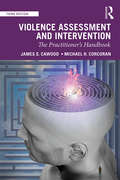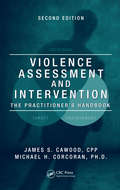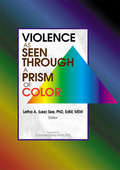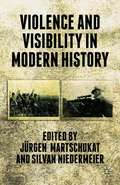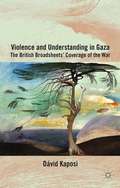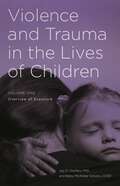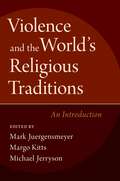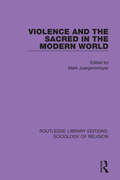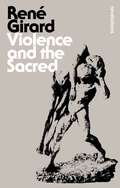- Table View
- List View
VIOLENCE AT THE URBAN MARGINS GCE C (Global and Comparative Ethnography)
by Javier Auyero, Philippe Bourgois and Nancy Scheper-HughesIn the Americas, debates around issues of citizen's public safety--from debates that erupt after highly publicized events, such as the shootings of Jordan Davis and Trayvon Martin, to those that recurrently dominate the airwaves in Latin America--are dominated by members of the middle and upper-middle classes. However, a cursory count of the victims of urban violence in the Americas reveals that the people suffering the most from violence live, and die, at the lowest of the socio-symbolic order, at the margins of urban societies. The inhabitants of the urban margins are hardly ever heard in discussions about public safety. They live in danger but the discourse about violence and risk belongs to, is manufactured and manipulated by, others--others who are prone to view violence at the urban margins as evidence of a cultural, or racial, defect, rather than question violence's relationship to economic and political marginalization. As a result, the experience of interpersonal violence among the urban poor becomes something unspeakable, and the everyday fear and trauma lived in relegated territories is constantly muted and denied. This edited volume seeks to counteract this pernicious tendency by putting under the ethnographic microscope--and making public--the way in which violence is lived and acted upon in the urban peripheries. It features cutting-edge ethnographic research on the role of violence in the lives of the urban poor in South, Central, and North America, and sheds light on the suffering that violence produces and perpetuates, as well as the individual and collective responses that violence generates, among those living at the urban margins of the Americas.
Violence at the Urban Margins (Global and Comparative Ethnography)
by Javier Auyero Philippe Bourgois Nancy Scheper-HughesIn the Americas, debates around issues of citizen's public safety--from debates that erupt after highly publicized events, such as the shootings of Jordan Davis and Trayvon Martin, to those that recurrently dominate the airwaves in Latin America--are dominated by members of the middle and upper-middle classes. However, a cursory count of the victims of urban violence in the Americas reveals that the people suffering the most from violence live, and die, at the lowest of the socio-symbolic order, at the margins of urban societies. The inhabitants of the urban margins are hardly ever heard in discussions about public safety. They live in danger but the discourse about violence and risk belongs to, is manufactured and manipulated by, others--others who are prone to view violence at the urban margins as evidence of a cultural, or racial, defect, rather than question violence's relationship to economic and political marginalization. As a result, the experience of interpersonal violence among the urban poor becomes something unspeakable, and the everyday fear and trauma lived in relegated territories is constantly muted and denied. This edited volume seeks to counteract this pernicious tendency by putting under the ethnographic microscope--and making public--the way in which violence is lived and acted upon in the urban peripheries. It features cutting-edge ethnographic research on the role of violence in the lives of the urban poor in South, Central, and North America, and sheds light on the suffering that violence produces and perpetuates, as well as the individual and collective responses that violence generates, among those living at the urban margins of the Americas.
Violence at Sea: Piracy in the Age of Global Terrorism
by Peter LehrViolence at Sea is an overview of maritime piracy, examining threats that piracy poses to global security and commerce, as well as measures and policies to mitigate the threat. The essays analyze piracy activities in key shipping lanes (including the African coast, the Arabian Sea, the Bay of Bengal, and the Straits of Malacca-South China Sea); piratical groups and their capabilities; case studies on overlaps between piracy, terrorism, and organized crime; legal and policy hurdles to combating piracy; tactical recommendations for combating piracy; and new trends and developments in the area. The counter response to maritime terrorism has been slow in coming, hampered by issues rooted in sovereignty, the laws of the sea, and the inherent challenges of international coordination. Yet given the likelihood that threats posed by piracy will not recede, but rather increase, all actors affected by maritime security will, sooner or later, need to address these challenges.
Violence at Sea: Piracy in the Age of Global Terrorism
by Peter LehrViolence at Sea is an overview of maritime piracy, examining threats that piracy poses to global security and commerce, as well as measures and policies to mitigate the threat. The essays analyze piracy activities in key shipping lanes (including the African coast, the Arabian Sea, the Bay of Bengal, and the Straits of Malacca-South China Sea); piratical groups and their capabilities; case studies on overlaps between piracy, terrorism, and organized crime; legal and policy hurdles to combating piracy; tactical recommendations for combating piracy; and new trends and developments in the area. The counter response to maritime terrorism has been slow in coming, hampered by issues rooted in sovereignty, the laws of the sea, and the inherent challenges of international coordination. Yet given the likelihood that threats posed by piracy will not recede, but rather increase, all actors affected by maritime security will, sooner or later, need to address these challenges.
Violence Assessment and Intervention: The Practitioner's Handbook
by James S. Cawood Michael H. CorcoranViolence Assessment and Intervention: The Practitioner’s Handbook, now in its third edition, provides a proven methodology, grounded in the current empirical research and the authors’ experience in successfully assessing and managing thousands of cases in a variety of contexts and environments, for analyzing concerning behaviors and potential threatening situations, and taking action in these challenging, dynamic environments before tragedy occurs. Threat and violence assessment and management is an essential process in reducing violence and its consequences. The ongoing challenge for those assessors, particularly in common workplace environments (e.g., educational settings, public agency settings, and business settings), is applying the applicable behavioral science research in a practical and effective manner to maximize safety. The book begins by demonstrating the threat and violence assessment process from the point of the initial call and proceeds through the steps that quantify the situation and determine the appropriate response. The next section covers information gathering, victimology, and formulas and tools for risk assessment. Finally, the book explores organizational influences, school violence, ethics, security and consultation issues; the formation and running of threat management teams, and relevant laws related to violence assessment. This book is a valuable reference for human resource professionals, security professionals, mental health practitioners, law enforcement personnel, and lawyers who are members of threat assessment teams, provide threat and violence assessment and management consultations, as well as expert witnesses in cases involving workplace violence, school violence, security negligence; or wrongful termination or disputed school disciplinary actions related to aggressive, threatening, or violent behavior.
Violence Assessment and Intervention: The Practitioner's Handbook
by James S. Cawood Michael H. CorcoranViolence Assessment and Intervention: The Practitioner’s Handbook, now in its third edition, provides a proven methodology, grounded in the current empirical research and the authors’ experience in successfully assessing and managing thousands of cases in a variety of contexts and environments, for analyzing concerning behaviors and potential threatening situations, and taking action in these challenging, dynamic environments before tragedy occurs. Threat and violence assessment and management is an essential process in reducing violence and its consequences. The ongoing challenge for those assessors, particularly in common workplace environments (e.g., educational settings, public agency settings, and business settings), is applying the applicable behavioral science research in a practical and effective manner to maximize safety. The book begins by demonstrating the threat and violence assessment process from the point of the initial call and proceeds through the steps that quantify the situation and determine the appropriate response. The next section covers information gathering, victimology, and formulas and tools for risk assessment. Finally, the book explores organizational influences, school violence, ethics, security and consultation issues; the formation and running of threat management teams, and relevant laws related to violence assessment. This book is a valuable reference for human resource professionals, security professionals, mental health practitioners, law enforcement personnel, and lawyers who are members of threat assessment teams, provide threat and violence assessment and management consultations, as well as expert witnesses in cases involving workplace violence, school violence, security negligence; or wrongful termination or disputed school disciplinary actions related to aggressive, threatening, or violent behavior.
Violence Assessment and Intervention: The Practitioner's Handbook, Second Edition
by Florian James S. Cawood Michael H. Corcoran Ph.D.Behavioral science has revealed a wealth of information concerning violence assessment in a wide variety of situations, but the challenge confronted by those dealing with potentially hostile populations is the effective application of this knowledge. Now in its second edition, Violence Assessment and Intervention: The Practitioner‘s Handbook, Secon
Violence as Usual: Policing and the Colonial State in German Southwest Africa
by Marie MuschalekSlaps in the face, kicks, beatings, and other forms of run-of-the-mill violence were a quotidian part of life in German Southwest Africa at the beginning of the twentieth century. Unearthing this culture of normalized violence in a settler colony, Violence as Usual uncovers the workings of a powerful state that was built in an improvised fashion by low-level state representatives.Marie A. Muschalek's fascinating portrayal of the daily deeds of African and German men enrolled in the colonial police force called the Landespolizei is a historical anthropology of police practice and the normalization of imperial power. Replete with anecdotes of everyday experiences both of the policemen and of colonized people and settlers, Violence as Usual re-examines fundamental questions about the relationship between power and violence. Muschalek gives us a new perspective on violence beyond the solely destructive and the instrumental. She overcomes, too, the notion that modern states operate exclusively according to modes of rationalized functionality. Violence as Usual offers an unusual assessment of the history of rule in settler colonialism and an alternative to dominant narratives of an ostensibly weak colonial state.
Violence as Seen Through a Prism of Color
by Letha A SeeSo many parts of society target citizens of color for violence--what can be done? Violence as Seen Through a Prism of Color examines violence from a structural perspective, including violence in prisons, schools and colleges, churches, homes, and within political/corporate structures.This unique, hard-hitting book argues that individual violence stems from the structure of our society and its institutions. Most of the contributors are African- American educators and practitioners who have a thorough understanding of structural violence. Some have experienced political violence; others have expert knowledge of structural violence within the criminal justice system, educational institutions, and elsewhere--even in churches and homes. Their writings are undeniably, unflinchingly authentic--it is impossible not to be moved and enraged by what they have to say. The good news is that in addition to calling attention to the structural violence in our society they provide excellent insights on how the situation might be resolved.Violence as Seen Through a Prism of Color shows: that much of the violence within the criminal justice system stems from decisions made at the highest levels of government that minority offenders are much more frequently convicted and more harshly sentenced than their white counterparts how cultural racism contributes to the construction of motives for lynching, hate crime, and police violence against Americans of color such as Abner Louima, Amadou Diallo, and Rodney King how the judicial system encourages black on black violence by neglecting to halt criminal activities in non-white neighborhoods how, in the words of Mahatma Gandhi, ”Poverty is the worst form of violence”You’ll also learn: how corporations are amassing great wealth through privatizing prisons and conscripting the labor of non-violent African-American prisoners how racial profiling affects people of color how the media has exploited black men imprisoned for minor drug offenses how and why violence occurs in and against the black churchHelpful charts and tables (like one that names the corporations that use prison labor) supplement the material--you’ll be surprised at what you learn! Extensive references are included at the end of each chapter.
Violence as Seen Through a Prism of Color
by Letha A SeeSo many parts of society target citizens of color for violence--what can be done? Violence as Seen Through a Prism of Color examines violence from a structural perspective, including violence in prisons, schools and colleges, churches, homes, and within political/corporate structures.This unique, hard-hitting book argues that individual violence stems from the structure of our society and its institutions. Most of the contributors are African- American educators and practitioners who have a thorough understanding of structural violence. Some have experienced political violence; others have expert knowledge of structural violence within the criminal justice system, educational institutions, and elsewhere--even in churches and homes. Their writings are undeniably, unflinchingly authentic--it is impossible not to be moved and enraged by what they have to say. The good news is that in addition to calling attention to the structural violence in our society they provide excellent insights on how the situation might be resolved.Violence as Seen Through a Prism of Color shows: that much of the violence within the criminal justice system stems from decisions made at the highest levels of government that minority offenders are much more frequently convicted and more harshly sentenced than their white counterparts how cultural racism contributes to the construction of motives for lynching, hate crime, and police violence against Americans of color such as Abner Louima, Amadou Diallo, and Rodney King how the judicial system encourages black on black violence by neglecting to halt criminal activities in non-white neighborhoods how, in the words of Mahatma Gandhi, ”Poverty is the worst form of violence”You’ll also learn: how corporations are amassing great wealth through privatizing prisons and conscripting the labor of non-violent African-American prisoners how racial profiling affects people of color how the media has exploited black men imprisoned for minor drug offenses how and why violence occurs in and against the black churchHelpful charts and tables (like one that names the corporations that use prison labor) supplement the material--you’ll be surprised at what you learn! Extensive references are included at the end of each chapter.
Violence as a Generative Force: Identity, Nationalism, and Memory in a Balkan Community
by Max BergholzDuring two terrifying days and nights in early September 1941, the lives of nearly two thousand men, women, and children were taken savagely by their neighbors in Kulen Vakuf, a small rural community straddling today’s border between northwest Bosnia and Croatia. This frenzy—in which victims were butchered with farm tools, drowned in rivers, and thrown into deep vertical caves—was the culmination of a chain of local massacres that began earlier in the summer. In Violence as a Generative Force, Max Bergholz tells the story of the sudden and perplexing descent of this once peaceful multiethnic community into extreme violence. This deeply researched microhistory provides provocative insights to questions of global significance: What causes intercommunal violence? How does such violence between neighbors affect their identities and relations? Contrary to a widely held view that sees nationalism leading to violence, Bergholz reveals how the upheavals wrought by local killing actually created dramatically new perceptions of ethnicity—of oneself, supposed "brothers," and those perceived as "others." As a consequence, the violence forged new communities, new forms and configurations of power, and new practices of nationalism. The history of this community was marked by an unexpected explosion of locally executed violence by the few, which functioned as a generative force in transforming the identities, relations, and lives of the many. The story of this largely unknown Balkan community in 1941 provides a powerful means through which to rethink fundamental assumptions about the interrelationships among ethnicity, nationalism, and violence, both during World War II and more broadly throughout the world.
Violence and Warfare among Hunter-Gatherers
by Mark W. Allen Terry L. JonesHow did warfare originate? Was it human genetics? Social competition? The rise of complexity? Intensive study of the long-term hunter-gatherer past brings us closer to an answer. The original chapters in this volume examine cultural areas on five continents where there is archaeological, ethnographic, and historical evidence for hunter-gatherer conflict despite high degrees of mobility, small populations, and relatively egalitarian social structures. Their controversial conclusions will elicit interest among anthropologists, archaeologists, and those in conflict studies.
Violence and Warfare among Hunter-Gatherers
by Mark W. Allen Terry L. JonesHow did warfare originate? Was it human genetics? Social competition? The rise of complexity? Intensive study of the long-term hunter-gatherer past brings us closer to an answer. The original chapters in this volume examine cultural areas on five continents where there is archaeological, ethnographic, and historical evidence for hunter-gatherer conflict despite high degrees of mobility, small populations, and relatively egalitarian social structures. Their controversial conclusions will elicit interest among anthropologists, archaeologists, and those in conflict studies.
Violence and Visibility in Modern History
by JüRGEN Martschukat Silvan NiedermeierDespite the claims of Steven Pinker and others, violence has remained a historical constant since the Enlightenment, even though its forms and visibility have been radically transformed. Accordingly, the studies gathered here recast debate over violence in modern societies by undermining teleological and reassuring narratives of progress.
Violence and Vengeance: Religious Conflict and Its Aftermath in Eastern Indonesia
by Christopher R. DuncanBetween 1999 and 2000, sectarian fighting fanned across the eastern Indonesian province of North Maluku, leaving thousands dead and hundreds of thousands displaced. What began as local conflicts between migrants and indigenous people over administrative boundaries spiraled into a religious war pitting Muslims against Christians and continues to influence communal relationships more than a decade after the fighting stopped. Christopher R. Duncan spent several years conducting fieldwork in North Maluku, and in Violence and Vengeance, he examines how the individuals actually taking part in the fighting understood and experienced the conflict.Rather than dismiss religion as a facade for the political and economic motivations of the regional elite, Duncan explores how and why participants came to perceive the conflict as one of religious difference. He examines how these perceptions of religious violence altered the conflict, leading to large-scale massacres in houses of worship, forced conversions of entire communities, and other acts of violence that stressed religious identities. Duncan’s analysis extends beyond the period of violent conflict and explores how local understandings of the violence have complicated the return of forced migrants, efforts at conflict resolution and reconciliation.
Violence and Understanding in Gaza: The British Broadsheets' Coverage of the War
by D. KaposiViolence and Understanding in Gaza is the first comprehensive investigation of the British broadsheets' coverage of the Gaza War. Written in accessible language and engaging style, it critiques the newspapers' output, which it is argued replicates the black and white logic of war instead of focusing on negotiations and peace.
Violence and Trauma in the Lives of Children [2 volumes]: [2 volumes]
Explains the neurological, emotional, and behavioral impacts of violence and trauma experienced by newborns, infants, children, and teenagers.Traumatic events known as adverse childhood experiences (ACEs) can affect children physically, mentally, and emotionally, sometimes with long-term health and behavioral effects. Abuse, neglect, exposure to community and domestic violence, and household dysfunction all have the potential to alter brain development and behavior, but few people are able to recognize or respond to trauma in children.Given the prevalence of childhood exposure to violence—with one in four children ages 5 to 15 living in households with only moderate levels of safety and nurturance and infants and children ages 0 to 3 comprising the highest percentage of those maltreated—it is imperative that students and professionals alike be able to identify types and consequences of violence and trauma. This book provides readers with the information they need in order to know how to detect and prevent ACEs and to help children who have lived through them.
Violence and Trauma in the Lives of Children [2 volumes]: [2 volumes]
Explains the neurological, emotional, and behavioral impacts of violence and trauma experienced by newborns, infants, children, and teenagers.Traumatic events known as adverse childhood experiences (ACEs) can affect children physically, mentally, and emotionally, sometimes with long-term health and behavioral effects. Abuse, neglect, exposure to community and domestic violence, and household dysfunction all have the potential to alter brain development and behavior, but few people are able to recognize or respond to trauma in children.Given the prevalence of childhood exposure to violence—with one in four children ages 5 to 15 living in households with only moderate levels of safety and nurturance and infants and children ages 0 to 3 comprising the highest percentage of those maltreated—it is imperative that students and professionals alike be able to identify types and consequences of violence and trauma. This book provides readers with the information they need in order to know how to detect and prevent ACEs and to help children who have lived through them.
Violence and the World's Religious Traditions: An Introduction
by Mark Juergensmeyer Margo Kitts Michael JerrysonIs religion inherently predisposed to violence? Or has religion been taken hostage by a politics of aggression? The years since the end of the Cold War have shown a noticeable shift in patterns of religious extremism, accentuating the uncomfortable, complex, and oft-misunderstood relationship between religion and violence. The essays in this succinct new volume examine that relationship by offering a well-rounded look at violence as it appears in the world's most prominent religious traditions, exploring Hindu, Buddhist, Chinese, Sikh, Jewish, Christian, Islamic, African, and Pacific Island texts and practices. The essays in Violence and the World's Religious Traditions explore the ways in which specific religions have justified acts of destruction, in history, in scripture, and in the contemporary world. But the collection also offers an investigation of religious symbols and practices, shedding new light on the very nature of religion and confronting the question of how deeply intertwined are violence and faith.
Violence and the state (PDF)
by Matthew Sussex Jan Pakulski Matt KillingsworthIn providing a counterweight to the notion that political violence has irrevocably changed in a globalised world, Violence and the state offers an original and innovative way in which to understand political violence across a range of discipline areas. It explores the complex relationship between the state and its continued use of violence through a variety of historical and contemporary case studies, including the Napoleonic Wars, Nazi and Soviet 'eliticide', the consolidation of authority in modern China, post-Soviet Russia, and international criminal tribunals. It also looks at humanitarian intervention in cases of organised violence, and the willingness of elites to alter their attitude to violence if it is an instrument to achieve their own ends. The interdisciplinary approach, which spans history, sociology, international law and International Relations, ensures that this book will be invaluable to a broad cross-section of scholars and politically engaged readers alike.
Violence and the state
by Matthew Sussex Jan Pakulski Matt KillingsworthIn providing a counterweight to the notion that political violence has irrevocably changed in a globalised world, Violence and the state offers an original and innovative way in which to understand political violence across a range of discipline areas. It explores the complex relationship between the state and its continued use of violence through a variety of historical and contemporary case studies, including the Napoleonic Wars, Nazi and Soviet 'eliticide', the consolidation of authority in modern China, post-Soviet Russia, and international criminal tribunals. It also looks at humanitarian intervention in cases of organised violence, and the willingness of elites to alter their attitude to violence if it is an instrument to achieve their own ends. The interdisciplinary approach, which spans history, sociology, international law and International Relations, ensures that this book will be invaluable to a broad cross-section of scholars and politically engaged readers alike.
Violence and the Sacred in the Modern World (Routledge Library Editions: Sociology of Religion #17)
by Mark JuergensmeyerHow is symbolic violence related to the real acts of religious violence around the modern world? The authors of this book, first published in 1992, explore this question with reference to some of the most volatile religious and political conflicts of the day: Hezbollah in Lebanon, Sikhs in India, militant Jewish groups in Israel, and Muslim movements from the Middle East to Indonesia. In addition to providing valuable insights into these important incidents, the authors – social scientists and historians of comparative religion – are responding to the theoretical issues articulated by René Girard in Violence and the Sacred (1977). The present volume is the first book of essays to test Girard’s theories about the social significance of religious symbols of violence against real, rather than symbolic, acts. In some cases his theories are found to be applicable; in other cases, the authors provide alternative theories of their own. In a concluding essay, co-authored by Mark Anspach, Girard provides a response.
Violence and the Sacred in the Modern World (Routledge Library Editions: Sociology of Religion #17)
by Mark JuergensmeyerHow is symbolic violence related to the real acts of religious violence around the modern world? The authors of this book, first published in 1992, explore this question with reference to some of the most volatile religious and political conflicts of the day: Hezbollah in Lebanon, Sikhs in India, militant Jewish groups in Israel, and Muslim movements from the Middle East to Indonesia. In addition to providing valuable insights into these important incidents, the authors – social scientists and historians of comparative religion – are responding to the theoretical issues articulated by René Girard in Violence and the Sacred (1977). The present volume is the first book of essays to test Girard’s theories about the social significance of religious symbols of violence against real, rather than symbolic, acts. In some cases his theories are found to be applicable; in other cases, the authors provide alternative theories of their own. In a concluding essay, co-authored by Mark Anspach, Girard provides a response.
Violence and the Sacred (Bloomsbury Revelations)
by René GirardRené Girard is one of the mostly widely-cited thinkers in contemporary European thought. First published in 1972, Violence and the Sacred marked the starting point of a substantial new phase of his thought. In this vivid study of human evil, Girard explores violence as it is represented and occurs throughout history, literature and myth. Girard's forceful and thought-provoking analyses of Biblical narrative, Greek tragedy and the lynchings and pogroms propagated by contemporary states illustrate his central argument that violence belongs to everyone and is at the heart of the sacred.
Violence and the Sacred (Bloomsbury Revelations)
by René GirardViolence and the Sacred is René Girard's landmark study of human evil. Here Girard explores violence as it is represented and occurs throughout history, literature and myth. Girard's forceful and thought-provoking analyses of Biblical narrative, Greek tragedy and the lynchings and pogroms propagated by contemporary states illustrate his central argument that violence belongs to everyone and is at the heart of the sacred.
